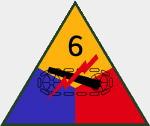Forces of Valor 81207 US M4A3 Sherman Medium Tank - 6th Armored Division "Super Sixth", Battle of the Bulge, 1944 (1:32 Scale)
"The only way you can win a war is to attack and keep on attacking, and after you have done that, keep attacking some more."
- General George S. Patton Jr., January 1945
 The M4 Sherman medium tank was regarded by many as the workhorse of the US Army during World War II. In fact, virtually all of the Allied armies employed the Sherman in their armed forces, including the British, who developed an upgunned variant called the "Firefly". Eleven different US plants manufactured six basic models of the Sherman, and by June 1944 over 49,234 battle-ready vehicles had been produced. While it was no match for the German Panther or Tiger tanks, the Sherman soldiered on, using its weight in numbers to wrest control of Europe from the Wehrmacht. The M4A3 was fitted with a long-barrel M1A1 76mm gun, which replaced the shorter and less effective 75mm gun, and sported a larger, more angular turret to house the bigger gun. In addition, the slope of the M4A3's frontal armor was changed to 47-degrees to increase frontal protection and simplify the production process.
The M4 Sherman medium tank was regarded by many as the workhorse of the US Army during World War II. In fact, virtually all of the Allied armies employed the Sherman in their armed forces, including the British, who developed an upgunned variant called the "Firefly". Eleven different US plants manufactured six basic models of the Sherman, and by June 1944 over 49,234 battle-ready vehicles had been produced. While it was no match for the German Panther or Tiger tanks, the Sherman soldiered on, using its weight in numbers to wrest control of Europe from the Wehrmacht. The M4A3 was fitted with a long-barrel M1A1 76mm gun, which replaced the shorter and less effective 75mm gun, and sported a larger, more angular turret to house the bigger gun. In addition, the slope of the M4A3's frontal armor was changed to 47-degrees to increase frontal protection and simplify the production process.
This particular 1:32 scale diecast replica of the famed US M4A3 Sherman medium tank was attached to the 6th Armored Division and used in the Battle of the Bulge winter counteroffensive.
Sold Out!
Dimensions:
Length: 7-1/2-inches
Width: 3-1/2-inches
Height: 3-3/4-inches
Release Date: July 2004
 Historical Account: "Super Sixth" - The 6th Armored Division was created February 15th, 1942 at Fort Knox, Kentucky and was made up almost entirely of citizen draftee soldiers. Its training stations were Camp Chaffee, Ark., Louisiana Maneuvers, the Mojave Desert, and Camp Cooke, CA. It arrived in England in February 1944 and landed at Utah Beach on July 18th, 1944. During the next 9-1/2 months, the 6th Armored fought in five major European campaigns including Normandy, Northern France, Ardennes-Alsace, the Rhineland and Central Europe, The majority of this time was spent in General George S. Patton's famous Third Army and played an instrumental role in the relief of Bastogne during The Battle of the Bulge.
Historical Account: "Super Sixth" - The 6th Armored Division was created February 15th, 1942 at Fort Knox, Kentucky and was made up almost entirely of citizen draftee soldiers. Its training stations were Camp Chaffee, Ark., Louisiana Maneuvers, the Mojave Desert, and Camp Cooke, CA. It arrived in England in February 1944 and landed at Utah Beach on July 18th, 1944. During the next 9-1/2 months, the 6th Armored fought in five major European campaigns including Normandy, Northern France, Ardennes-Alsace, the Rhineland and Central Europe, The majority of this time was spent in General George S. Patton's famous Third Army and played an instrumental role in the relief of Bastogne during The Battle of the Bulge.









